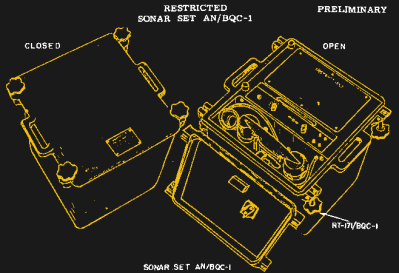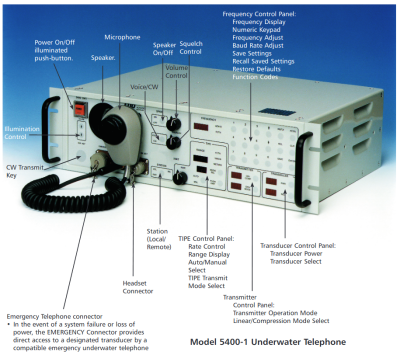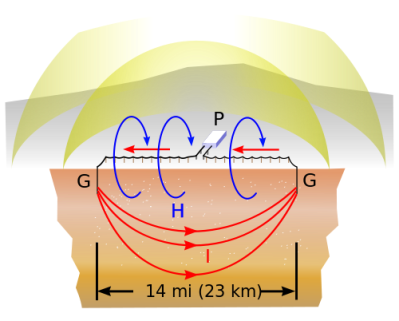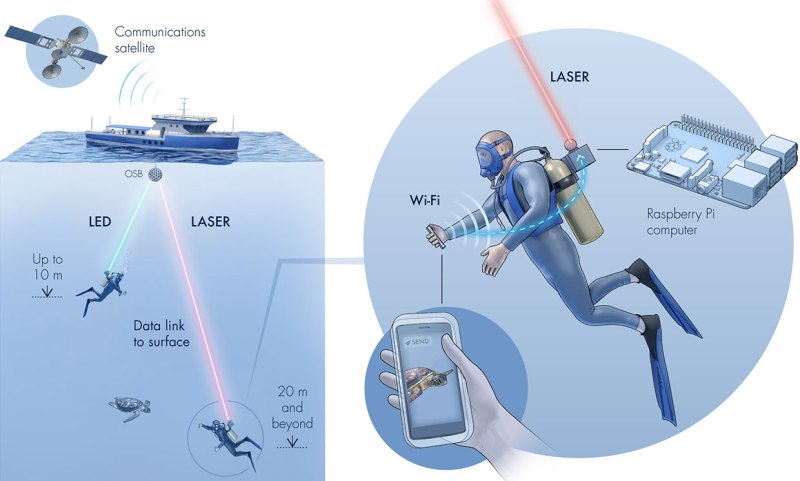It sometimes seems hard to believe that we humans have managed to explore so little of what we have so much of: the seas. Oceans cover something like 70 percent of the world’s surface, but we’ve only mapped 20 percent of the ocean floor. The 228,000 ocean-dwelling species that we know about represents about ten percent of the estimated total aquatic species. And almost all the life we know about, and the area that we’ve explored thoroughly, is limited to the first few hundred meters from the surface.
The paucity of our deep-water investigatory efforts has a lot to do with the hostility of the sea to those who haven’t evolved to survive in it. It takes extreme engineering and fantastically expensive machines to live and work even a few meters down, and even then submariners quickly become completely isolated from the rest of the world once they’re down there. Underwater communication is particularly challenging, since the properties of seawater confound efforts to use it as a communications medium.
Challenging though it may be, underwater communication is possible, and in this article we’ll take a look at a few modalities that have made operating under the sea possible, and a new technology that might just extend the Internet below the waves.
Hello, Gertrude?
For most of the early years of the Silent Service, once a submarine was submerged, it was on its own. For the submarines and U-boats of World War I, this fact was of little practical consequence since these boats operated mainly as surface vessels, submerging only to attack or to evade pursuit. There was little need for command authorities to contact them during the small fraction of time they were submerged, and as they mostly operated alone and attacked on the captain’s initiative.
Later in the century, as submarine tactics morphed into “Wolf Pack” attacks, the need for underwater communications between boats to coordinate attacks became clear. U-boat and submarine captains depended on their high frequency (HF) radios to communicate between boats in the pack and coordinate their attacks on convoys, but this could expose them to detection by opposing forces using radio direction-finding gear, and since they needed to be surfaced to use their radios, they were easy pickings for surface vessels and aircraft.

One of the earliest modes of underwater communication that the US Navy fielded was the AN/BQC-1 Underwater Telephone. This was a battery-powered and completely portable device that was used by surface vessels to communicate with submerged submarines, and for subs to communicate with each other. Commonly referred to as the “Gertrude”, the device was self-contained except for the hull-mounted transducer. The base unit had a telephone handset for voice communications between units; in addition, the Gertrude could be made to emit a 24.26 kHz audio tone to call to other vessels operating sonar sets using that frequency.
To transmit voice, the Gertrude used a modulation method that’s familiar to amateur radio operators: single-sideband. Just like radio waves, an acoustic carrier wave can be amplitude modulated. In the case of the Gertrude, the carrier wave was anywhere from 8.3375 kHz to 11.0875 kHz, and just like in radio, the receiver and transmitter had to be tuned to the same carrier frequency. On the transmitter side, the AM signal was filtered to remove the carrier wave and one of the sidebands, leaving a single-sideband signal that was applied to the transducer. The receiver demodulated the SSB signal with the standard product detector and beat-frequency oscillator arrangement, very similar to that used in SSB radio signals but at different frequencies.

The AN/BQC-1 Gertrude remained in service through the end of World War II and into the Cold War era. A more powerful unit, the AN/WQC-2, was put into service in 1945 and some version of the technology remains in almost every US Navy vessel to this day. Modern underwater telephones still use the SSB modulation scheme and still support the frequencies that were established by the Navy for the original Gertrude, even if the electronics behind it all has changed vastly over the intervening decades.
Low and Long
As useful as they are, acoustic underwater telephones have limited capabilities. The range on acoustic telephones is limited; the AN/BQC-1 was best used for voice comms at less than 500 yards (365 m), although its 24.26 kHz ping could reach out to ten times that distance. Acoustic waves are subject to all the same vagaries of propagation as radio waves are, with reflections off solid surfaces and diffraction by layers of differing water temperature or salinity resulting in multipath interference or even total loss of signal.
Submarines were also moving to a vastly different role in the Cold War years, as nuclear-powered boats came to the scene. Capable of months at sea, these boats became the perfect platforms for ballistic missiles, which would need to be in contact with command authorities to a degree that the skippers of WWII subs would never have thought possible. But radio waves generally don’t penetrate seawater, raising the problem of a sub having to periodically surface to check for new orders and losing its one tactical advantage: stealth.
To keep the subs safely below the surface, naval commands began exploring the very lowest end of the radio spectrum. While the high frequency (HF: 3 MHz to 30 MHz) and low frequency (LF: 30 kHz to 300 kHz) bands are perfectly capable of reaching across the globe thanks to ionospheric refraction, the high conductivity of seawater rapid attenuates signals in these bands.
Dialing down the spectrum a bit, the very low frequency (VLF: 3 kHz to 30 kHz) band starts to exhibit decent penetration of seawater, down to a depth of perhaps 20 meters. This is not deep enough to ensure the stealth of most submarines, which need to unfurl a long antenna wire to trail behind them as they cruise along far too close to the surface for comfort. VLF communications also suffer from bandwidth limitations, making voice communications impractical. VLF comms are therefore limited to a bit rate of 300 bps or so. Another disadvantage is that the huge antenna arrays and high power transmitters needed for VLF make two-way communications impossible.
Going even further down the spectrum, signals in the extremely low frequency (ELF: 3 Hz to 30 Hz) band are capable of penetrating 120 meters of seawater, which is deep enough for any submarine to maintain its stealth. The US Navy began investigating the ELF band in 1968 with Project Sanguine. With wavelengths from 10,000 to 100,000 kilometers, an ELF transmitter requires enormous antennas; indeed, the original proposal for an ELF station in Wisconsin would have buried antenna cables under 40% of the land area of the state. These cables would have coursed with 800 megawatts of power while transmitting.

Project Sanguine was never built, defeated by antiwar activists and budget hawks alike. Nor were the series of scaled-down ELF projects the Navy proposed built, until finally in 1989 Project ELF came online. There were two transmitters, one in Wisconsin and one in the Upper Peninsula of Michigan. The antenna feedlines are 14 to 28 miles (22 to 44 km) long, strung on wooden poles like utility lines and connected to enormous ground rods driven deep into the bedrock. When energized, current flowed between the ground rods and through the granite bedrock, creating a massive magnetic field that generated the ELF waves. It was basically a giant loop antenna made of rock.
The completed system was capable of sending a coded message on 76 MHz to a sub submerged 400 feet (122 m) off the coast of Florida. Unfortunately, the bandwidth of the signal was so low that it took 15 minutes to send a single three-character code group. Project ELF could only ever serve as a “bell-ringer” signal, to notify a sub to surface and use other means to receive a full message. The system was shut down in 2004 once VLF technology had advanced far enough that subs could use it without fear of detection.
WiFi Under the Waves
Limited bandwidth undersea comms certainly have their place, but being able to securely communicate underwater at high bit rates could be possible if new research pays off. In a recent paper, Basem Shihada et al from the King Abdullah University of Science and Technology have demonstrated a system they call “Aqua-Fi” that extends the Internet to the underwater realm. Using mainly off-the-shelf components, including a Raspberry Pi 3b, they were able to build an IEEE 802.11-compliant wireless network with a range of up to 20 meters. Both LEDs and lasers were used for emitters, with the lasers providing greater range but at the cost of directionality. In tests using waterproofed smartphones and blue and green lasers, they were able to achieve 2.11-Mbps and conduct Skype calls through the Aqua-Fi link.

It’s not likely that Aqua-Fi has much future as a network for submarines, but undersea warfare is far from the only activity such a system could support. Undersea research could benefit from making the Internet available below the surface; one could imagine a solar-powered buoy with a satellite link above the surface and a string of Aqua-Fi access points trailing into the deep below. Divers, remotely operated vehicles, or autonomous drones could take advantage of a full-time connection to the Internet, leading to advances in marine biology, geology, conservation, or even just recreation like sport diving. We can get down with that!
No comments:
Post a Comment